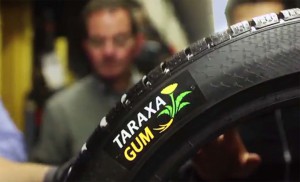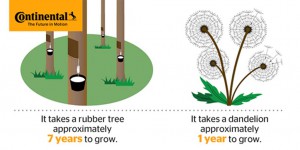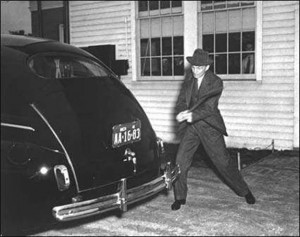They may be a nuisance for gardeners, but dandelions can find a place in salads and even can be made into wine. Now, what many consider a noxious weed could find an even more useful application: as a replacement for natural rubber.
German supplier Continental Tire hopes to put the synthetic material, known as taraxa gum, into production “in five to 10 years” as an alternative to conventional rubber tire treads. And industry researchers are developing other natural and recycled alternatives that are replacing wire insulation, plastic panels, carpets and even leather and suede.
Some of these environmentally friendly substitutes aren’t entirely new, however. Henry Ford was tinkering with soy-based compounds and recycling wood a full century ago. And, like then, researchers find some of these seeming solutions can create unexpected problems of their own.
“Most people view dandelions as a nuisance,” said a statement from Continental announcing its apparent breakthrough, “but here at Continental Tire, we embrace the flowering weed as a key component to the future of tires.”
It’s not the first time tire manufacturers went hunting for alternatives to rubber. Cut off from the plantations of Southeast Asia during the first years of World War II, the United States scrambled to find synthetic replacements. Some alternatives – especially those using fossil-based polymers –proved quite effective but could be costly, and often created environmental issues.
Continental isn’t the only tire company looking for alternatives to what is more formally known as India Rubber or caoutchouc. And the dandelion is actually just one of perhaps 1,200 different types of plants from which a similar latex polymer could be derived. One advantage is that it takes seven years to grow a rubber tree to the point where it can be tapped for sap. A crop of Russian dandelions – the best type for synthetic rubber — is ready in less than a year.
The search for alternatives isn’t entirely altruistic, however. “Natural rubber is a sustainable, renewable resource, but the problem is that the industry is growing so rapidly – building (over 80) million cars a year, now – that keeping up is a problem,” said Michael Martini, President of Consumer OE operations with Bridgestone Americas.
(Dutch company wants to turn plastic waste into roads. Click Here to see how.)
A combination of environmental needs and bottom line benefits is driving researchers to find new and cleaner sources for lots of other automotive materials, parts and components. In some cases, that may mean tapping plant-based materials while, in others, manufacturers are going the recycling route.
A number of carmakers are now using wires that rely on soy-based insulation, for example. But that serves as a warning that new switching compounds can create problems of their own.
Honda recently found itself the target of a class-action lawsuit claiming it used “defective” soy-based insulation that proved attractive to rats, rabbits and other critics who would chew on the insulation and cause potentially serious damage.
(For more on the Honda lawsuit, Click Here.)
Other than wood, soy was one of the first renewable plant materials the auto industry tapped into, largely driven by industry pioneer Henry Ford. Spurred by his friendship with the legendary botanist and inventor George Washington Carver, Ford focused on soybeans and other plant compounds. He even produced a virtually indestructible alternative to stamped steel using hemp, though it never went into mass production. Soybeans are another candidate to replace rubber, by the way.
Ford also was an early advocate of recycling, and repurposed the wood from shipping containers for the floorboards of his Model T.
Wood is a signature material for automotive interiors, luxury vehicles in particular. Forestry products giant Weyerhauser has come up with a different sort of tree-based material. Using waste scraps, its Cellulose Reinforced Polypropylene can be used as a substitute for fiberglass, for example. Three years ago, it went into use as a structural component in the Lincoln MKZ, and could see broader application in the near future.
Today, much of the steel the industry uses has been recycled, and a growing share of the aluminum – which is seeing expanded use for everything from suspension components to body panels as automakers push to reduce vehicle weight.
Carpeting and pedal covers are as likely as not to be made from recycled rubber or plastic. In fact, one of the hottest new interior materials, suede-like Alcantara, is made from recycled PET, the compound widely used for soft drink bottles.
While some of the compounds researchers have come up with have proven to be too costly, or simply too difficult to work with, the push for cleaner, greener automobiles is likely to see even more use of plant-based compounds, as well as recycled materials on future models.
(Automakers rack up awards for their newest green machines. Click Here for more.)





Oh? Don’t park your car where rodents can get at these ‘food-based’ items! I know of one Lexus with wiring getting eaten not once but twice! Needed to get the garage sealed rodent proof to avoid any more Lexus provided dinners!